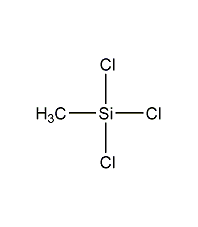Methyltrichlorosilane

Structural formula
| Business number | 01K4 |
|---|---|
| Molecular formula | CH3Cl3Si |
| Molecular weight | 149.48 |
| label |
Methylsilane, Trichloromethylsilane, Monomethyltrichlorosilane, Methyl silicon trichloride, Methyltrichlorosilane, Methyltrichlorosilane, Methyltriehlorosilane, Methyl silicochloroform, Methylsilicon trichloride, Elemental organic compounds |
Numbering system
CAS number:75-79-6
MDL number:MFCD00000481
EINECS number:200-902-6
RTECS number:VV4550000
BRN number:1361381
PubChem number:24897271
Physical property data
1. Properties: colorless liquid with pungent odor and easy to deliquesce. [1]
2. Melting point (℃): -90[2]
3. Boiling point (℃): 66.4[3]
4. Relative density (water = 1): 1.28[4]
5. Relative vapor Density (air=1): 5.2[5]
6. Saturated vapor pressure (kPa): 17.9 (20℃)[6]
7. Critical pressure (MPa): 3.53[7]
8. Octanol/water partition coefficient: 2.01[8]
9. Flash point (℃): -9 (CC); 7.2 (OC) [9]
10. Ignition temperature ( ℃): 490[10]
11. Explosion upper limit (%): 11.9[11]
12. Explosion Lower limit (%): 7.2[12]
13. Solubility: soluble in benzene and ether. [13]
Toxicological data
1. Skin/eye irritation
Standard Draize test: rabbit, skin contact: 500μL; severity of reaction: severe.
Standard Draize test: Rabbit, eye contact: 5mg/24H; Severity of reaction: Severe.
2. Acute toxicity: Rat oral LD50: 1620μL/kg; rat inhalation LC50: 450ppm/4H; rat intraperitoneal LDLo: 30mg/kg; mouse inhalation LC50: 180mg/ m3/2H; Rabbit skin contact LD50: 840μL/kg;
3. Acute toxicity[14]
LD50: 1620μl (2173.6mg)/kg (rat oral); 840μl (1075.2mg)/kg (rabbit transdermal)
LC50 : 450ppm (rat inhalation, 4h)
4. Irritation[15]
Rabbit transdermal: 500μl, severe stimulation.
Rabbit eye: 5mg (24h), severe irritation.
Ecological data
1. Slightly harmful to water, avoid undiluted or large amounts of product coming into contact with groundwater, waterways or sewage systems.
2. Ecotoxicity No data available
3. Biodegradability No data
4. Non-biodegradabilityNo information yet
Molecular structure data
1. Molar refractive index: 29.94
2. Molar volume (cm3/mol): 114.9
3. Isotonic specific volume (90.2K ): 246.4
4. Surface tension (dyne/cm): 21.1
5. Polarizability (10-24cm3): 11.87 p>
Compute chemical data
1. Reference value for hydrophobic parameter calculation (XlogP): None
2. Number of hydrogen bond donors: 0
3. Number of hydrogen bond acceptors: 0
4. Number of rotatable chemical bonds: 0
5. Number of tautomers: none
6. Topological molecule polar surface area 0
7. Number of heavy atoms: 5
8. Surface charge: 0
9. Complexity: 28.4
10. Number of isotope atoms: 0
11. Determine the number of atomic stereocenters: 0
12. Uncertain number of atomic stereocenters: 0
13. Determine the number of chemical bond stereocenters: 0
14. Number of uncertain chemical bond stereocenters: 0
15. Number of covalent bond units: 1
Properties and stability
1. Stability[16] Stable
2. Incompatible substances[17] Strong acid, strong alkali, strong oxidant, water
3. Conditions to avoid contact[18] Humid air, heat
4. Polymerization hazard[19] Polymerization
5. Decomposition products[20] Hydrogen chloride
Storage method
Storage Precautions[21] Store in a cool, ventilated warehouse. Keep away from fire and heat sources. The storage temperature should not exceed 37℃. The packaging must be sealed and must not come into contact with air. They should be stored separately from oxidants, acids, alkalis, etc. and avoid mixed storage. Use explosion-proof lighting and ventilation facilities. It is prohibited to use mechanical equipment and tools that are prone to sparks. The storage area should be equipped with emergency release equipment and suitable containment materials.
Synthesis method
Methyl chloride and silicon powder are directly synthesized in the presence of cuprous chloride catalyst in the next step to generate a methylchlorosilane mixture, which is purified by distillation to obtain the product dimethyldichlorosilane. Then use vacuum distillation to separate and purify. 
Purpose
Used in the manufacture of silicone compounds. [22]
extended-reading:https://www.newtopchem.com/archives/category/products/page/161extended-reading:https://www.bdmaee.net/cas814-94-8/extended-reading:https://www.newtopchem.com/archives/76extended-reading:https://www.bdmaee.net/wp-content/uploads/2022/08/Polyurethane-thermal-delay-catalyst-NT-CATE-129-heat-sensitive-metal-catalyst.pdfextended-reading:https://www.bdmaee.net/toyocat-et/extended-reading:https://www.newtopchem.com/archives/category/products/page/71extended-reading:https://www.cyclohexylamine.net/foaming-retarder-high-rebound-retardation-catalyst-high-rebound-delayed-catalyst-c-225/extended-reading:https://www.newtopchem.com/archives/40526extended-reading:https://www.bdmaee.net/pc-cat-td33eg-catalyst/extended-reading:https://www.newtopchem.com/archives/44024
